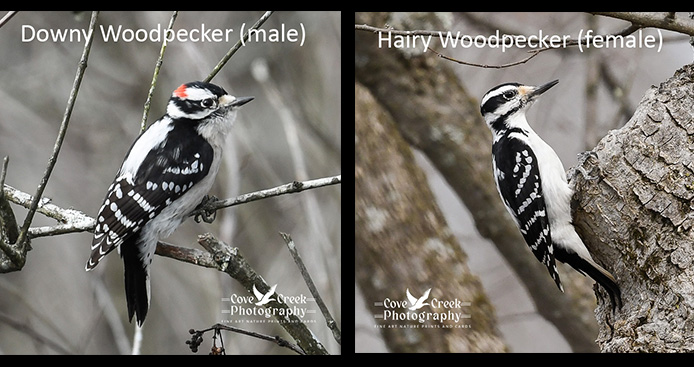
The tiniest of the woodpeckers in North America, the Downy Woodpecker (Dryobates pubescens), is a resident bird in Arkansas and throughout the United States and Canada. You can find these birds in a variety of habitats; from deciduous or mixed pine and hardwood forests to your own backyard. I have a pair of Downy Woodpeckers that visit my suet feeders year round. The routine is the same at every visit. Male and/or female downy woodpecker land in a nearby tree, often announcing their arrival. In a short time one will visit the feeder, but never both at the same time. When visiting a backyard birdfeeder, downy woodpeckers don't seem bothered by other small songbirds and will feed along side of them.
Whether you see them in the forest or at your birdfeeders, downy woodpeckers are fairly simple to identify. Their length is 5 1/2 to 6 3/4 inches, and they weigh in at 1 ounce, sometimes slightly less than that. Compared to a Chickadee, they appear slightly larger, and compared to a Nuthatch, they look about the same size. Their color pattern is characterized by horizontal rows of white patches on the wings, and there is a wide white stripe down the back. A male Downy Woodpecker can be distinguished from the female by the red patch on the back of its head.
On the other hand, downy woodpeckers are sometimes difficult to distinguish from hairy woodpeckers (Dryobates villosus), which occupy the same range and exploit the same habitats as downy woodpeckers. Color pattern is essentially the same between these two species, but the hairy woodpecker is larger at 7 to 10 inches in length. Additionally, the bill is about as long as the head, in contrast to the much smaller bill of the downy woodpecker. These two characteristics can be very difficult to estimate from a distance. When either of these species is at a birdfeeder or a short distance away, the difference in body size and bill length is fairly obvious. At a distance, a telephoto lens helps up to a certain point. However, my "go to" is to get a good look at the tail, if possible. If I see black spots on the outer tail feathers, it's definitely a downy woodpecker. If the white outer tail feathers lack black spots, it's a hairy woodpecker.
Ultimately, I see a lot of downy woodpeckers when I am hiking through forests in the southeastern United States. I see hairy woodpeckers only occasionally, but with a telephoto lens and estimating bird size using tree branches for scale, I am able to correctly identify the species.
-------------------------------------------------------------------------
**Metrics (bird length and weight) are referenced from the Cornell Lab of Ornithology (www.allaboutbirds.org; accessed 18 Jan 2022). All other anecdotal descriptions and observations are my own.**
